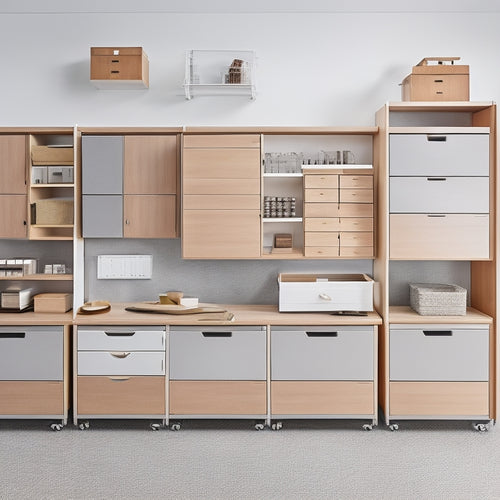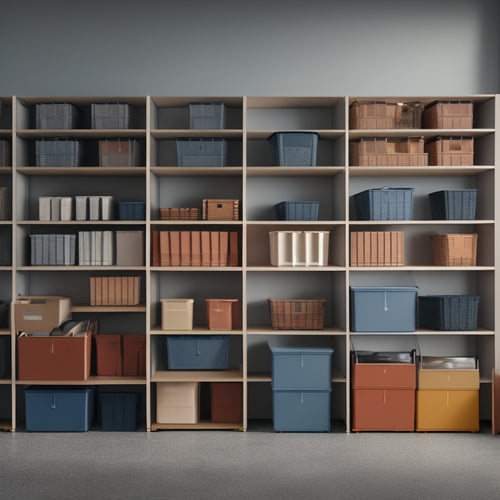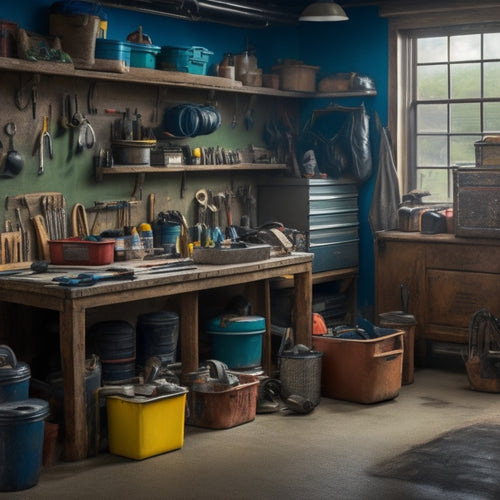
Building Garage Shelves in 7 Easy Steps
Share
You're about to convert your garage into a highly functional storage space by building custom shelves in just 7 easy steps. Start by preparing your garage space, clearing the floor, and inspecting for obstructions. Next, plan your shelf design, considering factors like durability, accessibility, and aesthetics. Gather essential materials and tools, like 2x4 lumber, plywood, and power tools, and assemble the shelf frame with sturdy materials and secure attachment. Then, add shelves and supports, install them securely, and finish with trim and molding. By following these steps, you'll be on your way to creating a customized storage solution that meets your specific needs, and with a few more details, you'll be able to maximize your garage's potential.
Key Takeaways
- Prepare the garage space by clearing the floor, inspecting walls and ceiling, and assessing the floor for cracks or unevenness.
- Plan the shelf design considering the primary purpose, available space, durability, accessibility, and aesthetic choices.
- Gather essential materials and tools, including lumber, plywood, wood screws, wood glue, and power tools, and ensure accurate calculations to minimize waste.
- Design for durability by assessing load capacity, choosing sturdy materials, and ensuring shelf brackets are securely attached to support weight.
- Assemble the shelf frame using proper techniques, and install shelves and supports securely, following manufacturer's instructions and considering weight capacity.
Prepare the Garage Space
As you begin building garage shelves, preparing the garage space is essential to guarantee a successful project. This step is pivotal for effective garage organization and space optimization.
Clear the garage floor by removing everything, including cars, boxes, and equipment. Sweep or blow leaves and debris out of the garage to confirm a clean working surface. Check the walls and ceiling for any obstructions, such as pipes or ductwork, that may interfere with your shelving design. Take note of any electrical outlets or switches that need to be avoided.
Next, examine the garage floor for any cracks or unevenness. Fill in any cracks with a concrete patching compound and let it dry according to the manufacturer's instructions. If the floor is uneven, consider using adjustable feet on your shelves to compensate.
Plan Your Shelf Design
You'll need to define the purpose of your shelves to determine the type of materials you'll store and the weight capacity required.
Next, measure the available space in your garage to determine the maximum size of your shelves.
With these factors in mind, you can design your shelves for durability, ensuring they'll withstand the weight and usage they'll receive.
Shelf Purpose Defined
Most garage shelves serve multiple purposes, but identifying your primary needs will help you design a shelving system that efficiently meets those needs.
You'll need to determine the shelf weight capacity required to hold your stored items. Consider your storage needs: what items will you be storing, and how often will you need to access them? This will influence your organization strategies, such as categorizing items by frequency of use or grouping similar items together.
Accessibility considerations are also vital. Think about the height and depth of your shelves, as well as the aisle space between them. You'll want to guarantee easy access to your stored items while maintaining a safe and clutter-free environment.
Aesthetic choices, like the color and material of your shelves, may also impact your design. As a DIY enthusiast, you'll need to balance your design goals with your DIY methods and skills.
Measure Available Space
With your shelf purpose defined, it's time to turn your attention to the available space in your garage. You'll need to measure the area where you plan to install your shelves to guarantee a perfect fit.
Start by recording the dimensions of the wall, including any obstructions like windows, doors, or electrical outlets. Next, measure the space between the wall studs, typically 16 inches on center, to determine the best shelf placement for maximum support.
Use measurement techniques like a tape measure or a laser level to verify accuracy. Take note of any sloping floors or uneven walls that may affect your shelf design.
Consider space optimization by planning your shelves around any existing features, like a workbench or cabinets, to create a functional and efficient workspace.
Record all your measurements and observations to create a detailed map of your garage's available space. This will help you design shelves that fit seamlessly into the space, providing ample storage while maintaining a safe and accessible environment.
Design for Durability
Frequently, a well-designed shelving system is only as strong as its weakest component, making it vital to plan your shelf design with durability in mind from the outset.
You want your shelves to support the weight of the items you'll be storing, so consider the load capacity of your shelves. Think about the types of items you'll be storing and their combined weight. This will help you determine the necessary shelf stability and load capacity.
When designing your shelves, consider the materials you'll use. You'll want to choose materials that are sturdy and can support the weight of your items.
For example, 3/4-inch plywood or oriented strand board (OSB) are good options for shelf boards.
You'll also want to guarantee that your shelf brackets are securely attached to the wall and can support the weight of your shelves and items.
Gather Essential Materials
You'll need specific tools to build your garage shelves, including a circular saw, drill, and level, as well as materials like plywood, lumber, and screws.
The shelf design options you chose in the previous step will dictate the quantities of each material you'll need to buy.
Make certain to calculate these quantities accurately to avoid waste and guarantee a successful project.
Required Tools
About three-quarters of your garage shelving project's success depends on having the right tools for the job. You'll need a mix of power tools and hand tools to get the job done efficiently and safely.
Start with the power tools: a circular saw for cutting lumber, a drill press for precise drilling, and an impact driver for driving screws. Don't forget a jigsaw or a reciprocating saw for curved cuts or demo work.
For hand tools, you'll need a tape measure, level, and clamps to guarantee accurate and secure assemblies. A hammer, screwdrivers, and pliers will also come in handy.
Remember to take safety precautions when using these tools. Wear protective gear like safety glasses, ear protection, and a dust mask. Confirm your tools are properly maintained to prevent accidents.
Regularly clean and lubricate your tools, and keep them in good working condition. By having the right tools and following proper safety guidelines, you'll be well on your way to building sturdy garage shelves.
Shelf Design Options
With your tools ready, it's time to shift your focus to designing your garage shelves. You have various options to choose from, depending on your needs and preferences.
If you want a sleek, modern look, consider floating shelves or wall mounted shelves. For maximizing corner space, corner shelves are a great option. Adjustable shelving allows you to customize the height and spacing of your shelves, while modular shelving provides flexibility and ease of installation.
Heavy duty shelves are perfect for storing heavy items, such as tools or equipment. Decorative shelving adds a touch of style to your garage, while open shelving keeps items visible and accessible. Storage cubes are great for organizing small items, and shelving brackets provide additional support and stability.
Consider the weight capacity, material, and durability of each option to guarantee your shelves are safe and functional. Take your time to plan and design your garage shelves, and you'll be ready to start building in no time.
Material Quantities Needed
Before diving into the building process, take stock of the materials you'll need to bring your garage shelving design to life.
You'll want to guarantee you have the right wood types and quantities to support your desired weight capacity. For a standard 8-foot shelf, you'll need:
- 2 x 4 lumber for the vertical supports (4-6 pieces, depending on shelf spacing)
- 3/4-inch plywood or MDF for the shelf boards (2-3 sheets, depending on shelf size and thickness)
- Wood screws for assembling the frame (1-2 boxes, depending on screw size and quantity)
- Wood glue for reinforcing joints
- Sandpaper and a drill for prep and assembly
Consider the weight capacity you need for your shelves, as this will impact the type and quantity of materials required.
For heavy-duty storage, you may need to upgrade to thicker plywood or specialized shelving materials. Always prioritize safety and stability when building garage shelves.
Remember to double-check your measurements and material quantities before heading to the hardware store.
Accurate calculations will save you time and money in the long run.
Assemble the Shelf Frame
Get your drill ready and start by attaching the shelf frame's side panels to the top and bottom panels using 2.5-inch screws. Make certain they're aligned properly to guarantee frame stability. Use a level to double-check the frame's verticality.
Next, attach the back panel to the frame using 1.5-inch screws. This will provide additional stability to the shelf frame. Use a clamp to hold the back panel in place while you screw it in.
When assembling the frame, use proper assembly techniques to avoid any weak points. Don't overtighten the screws, as this can cause the wood to split. Instead, use a steady, consistent pressure to secure the panels together.
As you assemble the frame, be sure to check your work regularly to avoid any mistakes. Measure twice, and screw once to guarantee accurate assembly.
With the frame assembled, you'll be ready to move on to the next step and add the shelves and supports.
Add Shelves and Supports
You'll need to determine the perfect shelf spacing for your garage storage needs. Consider the size and weight of the items you plan to store, as well as the shelf materials you're using. This will help you decide on the best shelf spacing to guarantee stability and prevent collapse.
When selecting shelf materials, consider the weight capacity you need. A sturdy shelf material like 3/4-inch plywood or MDF is perfect for heavy items, while lighter materials like 1/2-inch plywood or oriented strand board (OSB) may be sufficient for lighter loads.
Here's a general guide to help you choose the right shelf material and spacing:
| Shelf Material | Recommended Shelf Spacing | Weight Capacity |
|---|---|---|
| 3/4-inch Plywood | 12-18 inches | 50-75 pounds per square foot |
| 1/2-inch Plywood | 18-24 inches | 25-50 pounds per square foot |
| MDF | 12-18 inches | 50-75 pounds per square foot |
| OSB | 24-30 inches | 10-25 pounds per square foot |
| Adjustable Shelf | Varies | Varies |
Remember to always follow the manufacturer's instructions for the specific shelf materials and supports you're using.
Install the Shelves Securely
Secure shelves start with a solid foundation, so begin by marking the wall studs where you'll attach the shelf supports.
Use a level to guarantee the marks are straight and a stud finder to locate the studs. Next, attach the shelf supports to the marked studs using screws or bolts, making sure they're securely fastened.
Now, place the shelves onto the supports, confirming they're evenly spaced and level. Use screws or nails to secure the shelves to the supports, distributing the weight evenly across the shelf.
This is vital for shelf stability, as uneven weight distribution can lead to collapse. Make sure the shelves can hold the intended weight, considering the weight of the items you'll be storing.
Double-check that all screws and nails are securely fastened to prevent the shelves from shifting or collapsing. By following these steps, you'll have shelves that are both functional and safe.
Add Finishing Touches
With your garage shelves now securely in place, it's time to focus on adding those finishing touches that will make your storage space both functional and visually appealing.
To enhance shelf aesthetics, consider adding a trim or molding to conceal any exposed edges or screws. This won't only improve the overall look but also provide a safer environment by reducing the risk of accidental cuts or scratches.
Next, focus on storage organization by categorizing and grouping similar items together. This will optimize your space and make it easier to find what you need when you need it.
Consider using bins, baskets, or labels to further optimize your storage space.
Frequently Asked Questions
Can I Use Reclaimed or Second-Hand Wood for My Garage Shelves?
You can use reclaimed or second-hand wood for your project, but make sure to inspect it carefully for damage or rot and apply wood treatment to prevent pest or decay issues, ensuring a safe and sturdy structure.
How Do I Ensure My Shelves Can Hold Heavy Storage Bins?
You'll guarantee your shelves can hold heavy storage bins by selecting sturdy shelf materials and focusing on weight distribution; consider using thick, dense woods or metal frames, and space bins evenly to prevent collapse or bowing.
Are There Any Specific Safety Considerations for Garage Shelving?
When installing garage shelving, you'll want to prioritize shelf stability and weight distribution to guarantee safety. You'll need to secure shelves to walls to prevent tipping, and evenly distribute weight to prevent collapse, avoiding accidents and injuries.
Can I Add Doors or Cabinets to My Garage Shelving System?
You can definitely add doors or cabinets to your garage shelving system, enhancing your shelf design and storage solutions. Consider load capacity, material durability, and secure fastening to guarantee stability and safety when integrating these features.
Do I Need a Permit to Build Garage Shelves in My Area?
Before you start hammering, investigate if your local building and zoning regulations require a permit for garage shelving installations, as requirements vary, and you don't want to risk costly revisions or even demolition.
Conclusion
You've built it, and now you can conquer it! Your garage shelves, once a mere idea, now stand tall, ready to hold the weight of your organized dreams. Like a lighthouse of hope in a cluttered wilderness, your shelves shine, illuminating the path to a more streamlined you. So, go ahead, load them up, and reap the benefits of your hard work. Your garage, once a chaotic storm, is now a serene haven, thanks to your DIY prowess.
Related Posts
-

Modular Tool Storage Systems for Small Spaces
You can optimize your small workspace by leveraging modular tool storage systems that intelligently employ vertical s...
-

Choosing the Right Stacked Storage Bins
When choosing the right stacked storage bins, you'll want to evaluate your storage needs, considering inventory types...
-

Best Cheap Tool Boxes for Budget-Conscious Buyers
You need a reliable tool box that gets the job done without breaking the bank. Look for durable materials, rust-resis...


